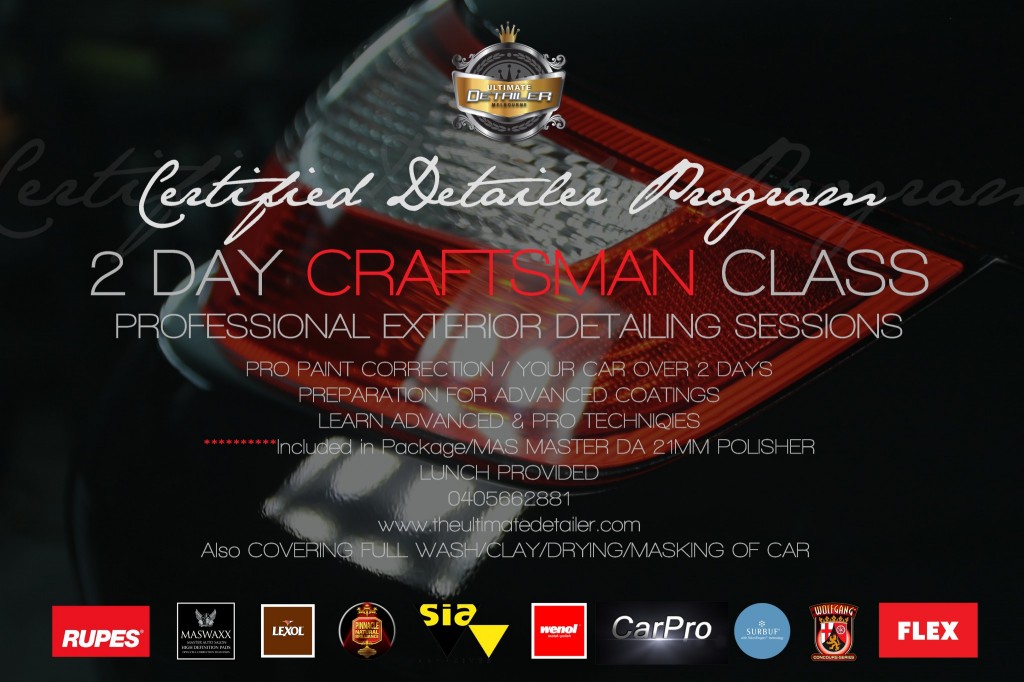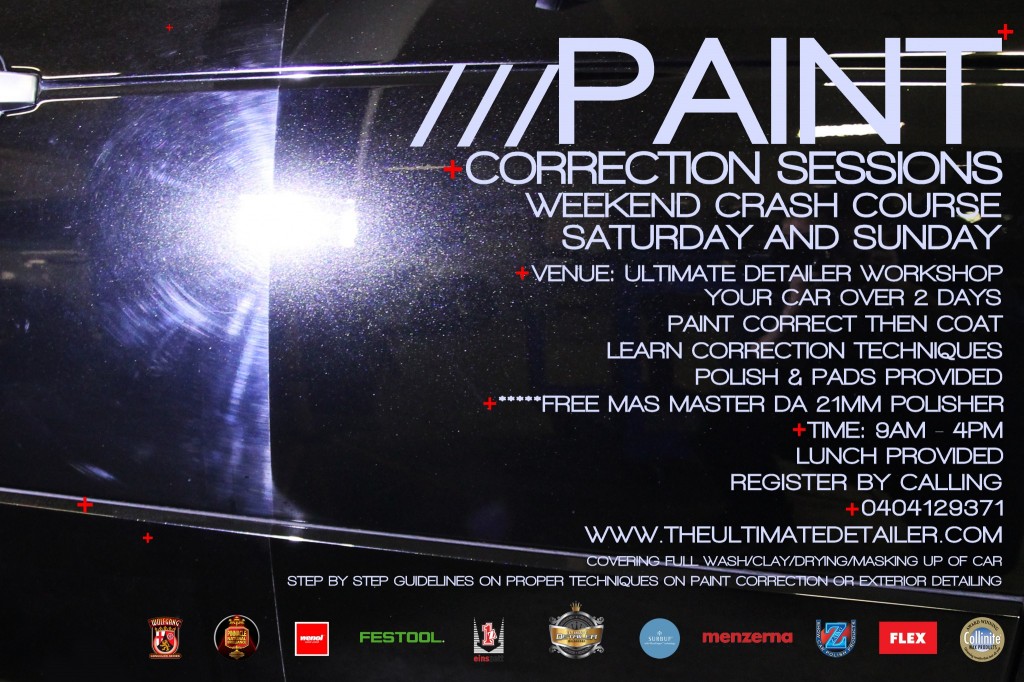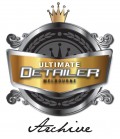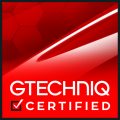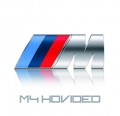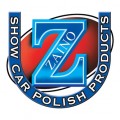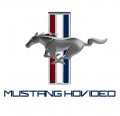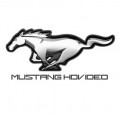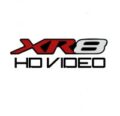Crash Weekend Course – Paint Correction Sessions
Weekend Crash Course to Introduce Paint Correction to your vehicle and go through different paint systems. Text or Call 0405662881
Optional***** DA 21MM Polisher. Pads and High Quality Exclusive German Polishes that will master Paint Correction Techniques.
By The Weekend, your Vehicle will go through the full steps in learning and understanding key elements in efficient Paint Correction.
Car Detailing Courses Full Album
Professional Car/Automotive Detailing – Full Course
- Introduction To Your Detail Package
- Course Description: Your Goals & Objectives
- The Steps of a Professional Auto Detail
- The Art of Auto Detailing
- Identifying All Types of Paint Flaws
- Explain Corrective Action Techniques
- Description of Proper Chemical Usage: Interior & Exterior
- Review Marketing & Business Promotion Strategies
- Generating Retail & Wholesale Customers
- Proper Bidding & Estimating
- Up-selling and Cross-selling Additional Services
- Managing Chemical Costs
- MSDS Manual
- Understanding the Importance of Safety
(Training Courses are non-refundable)
Auto Detailing Training 101 is the auto detail industry’s most comprehensive business course! It’s taught by our team of marketing and detailing experts and is only available to The Ultimate Detailer graduates. This course will walk you through every aspect of the detailing business and will help prepare you to be a professional, providing you with the proper knowledge you’ll need to be successfully sell yourself and your newly learned skills.
Sales Skills starts with the selling of yourself, then the services you provide. Confidence is a must, that’s why we place so much emphasis on proper detailing training and troubleshooting. Selling is a large part of your job as a detailer and probably the most important.
Pride and satisfaction in knowing you’ve done a good job is a wonderful reward, sometimes better than getting paid. Our aim is to educate you “A-Z” about the technical and business aspects.
- Plan on learning how to sell yourself and the quality services you offer.
- Learn how to price your work and tips for exceeding your customer’s expectations.
- Tips for generating lots of referral and repeat business.
- Promotional flyers that really work to sell your services while you’re out working.
- The benefits of providing maintenance contracts for your customer’s.
- How to increase your average invoice by offering additional appearance services.
Generating Retail and Wholesale Customers can be an important strategic decision when commencing your new detail business. We’ll share with you our experiences and highlight the effects on cash flow and gross profit.
Mobile or Fixed Based Businesses require different cash outlays. Starting out does not have to be expensive. Let us explain the most effective use of your start up capital and the benefits and drawbacks of both business models.
Car Detailing Courses Full Album
Interior Cleaning Training
- Deep Cleaning Hot Water Extractor Usage for:Vinyl Dressing of All Interior Components
- Carpets and Trunks
- Upholstery Seats
- Stain Removal
- Carpet Dyeing
- Vacuuming
- Dashboards & Headliner Conditioning
- Leather Cleaning & Conditioning Process
- Glass Cleaning Techniques: No Haze or Streaks
- Odor Removal
- Techniques for Cleaning Nooks & Crevices
Interior Cleaning, while not first thing your customer will notice when approaching their freshly detailed auto, is definitely one of the most important aspects of a professional detail. It’s where your customer will spend the most time. The interior is where you can make or break a detailing job.
In this part of the course we’ll focus on all the details of the interior. Interior training includes thorough hands-on instruction on how to correctly vacuum, air purging of the nooks, headliner cleaning, prevention of glass streaking, plastic care, dash boards, console crevices, stain removal, odor elimination and the cleaning and conditioning of vinyl and leather.
What to Expect to Learn:
- Interior cleaning techniques for removing floor mats and debris too large to be removed with initial vacuuming.
- How to vacuum the interior thoroughly including under the seats, ashtrays and cracks of the seats.
- Pre-soaking of tough stains in carpets, cloth or velour seats.
- Deep cleaning of all carpeted areas and upholstery using the hot water extractor. Carpet extractors are an important tool for removing all sorts of tough stains, including grease, dirt and stubborn spills that have dried.
- How to quickly match colors when dying carpets that are faded or stained.
- Selecting the correct dressing for vinyl interiors that don’t attract dust and the suns damaging UV rays.
- Tips for proper leather conditioning to help maintain the strength, beauty and utility of your customer’s leather seats. Also covered are techniques for evenly distributing conditioner with special applicators for deep penetration, without leaving any greasy or tacky surfaces
- Techniques for eliminating tough cigarette and mildew odors
- Where not to apply dressing such as the gas pedal, brake pad or clutch pedal as they become slippery and hazardous
- Glass cleaning without leaving hazing or streaking
- Preparing for The Wash
- Use of Power Washers
- Bug & Tar Removal
- Wheel Cleaning & Polishing
- Cleaning & Dressing Exterior Trim
- Door Jambs Degreasing
- The Engine Compartment
- Cleaning the Engine
- Dressing the Engine
- Proper Use of Polishers & Buffers
- High Speed Polisher
- Cyclo Dual Head Polisher
- Orbital Buffer
- Buffing Pad Selection
- What Detail Chemicals to Use for Correcting Attention to Detail Training – The Inspection Process
- Oxidized & Faded Paint
- Water Spots
- Overspray Removal
- Industrial Fallout
- Swirl Removal
- Surface Scratches
- Deeper Scratches
- All Types of Paint Blemishes
Exterior Cleaning involves washing the car; tire and wheel care and of course surface preparation and paint care. In this part of our course, you’ll learn:
3 Tips to avoid scratching of the vehicles paint during the wash process.
- Wash from top to bottom (this avoids bringing dirt from the lower part of the vehicle to the mid panel areas) and wash with a Ph balanced Auto wash soap (not dish soap as it contains harsh detergents that can harm the paint).
- Use two buckets; one for your car wash soap and water and the other just water. When completed cleaning one section of the car, rinse the wash glove in the bucket of plain water. This will prevent dirt caught in the wash glove from scratching the auto’s surface.
- Use a gentle stream of flowing water to avoid scratches. Excessive water pressure will cause the dirt to grind at the surface, causing unnecessary paint damage.
- Selecting the correct drying towels to prevent scratching and swirls
- Cleaning agents for the safe and effective removal of tar and bug debris.
- The details are in the door jambs. You never want a customer to open their door to find residual wax or unclean grease or dirt.
- Polishing techniques which will help to improve surface gloss and removal of minor swirls and paint blemishes.
- How to create a perfect mirror-like shine; even for deeply oxidized and poorly cared for paint.
- The correct polishes and waxes to use on different types of surfaces.
- Simple rules for applying products by hand or by machine.
- Tips for avoiding wax buildup on trim, rubber, as well as for cracks and crevices.
- Learn how waxing and ongoing maintenance can create a transparent barrier between the paint’s finish and the harmful effects of the sun, acid rain, salt, pollution, bird droppings.
- The benefits for the use of a clay bar for removing contamination on a vehicles surface. Such contamination can be the build up of tiny metal shavings from rail dust, brake dust, and industrial fallout. Because a car clay bar isn’t abrasive, it can safely and efficiently remove overspray, without scratching the Auto’s paint finish. They’re also effective at removing tree sap and water spots.
Additionally, we’ll teach you all about the most common paint surface issues and tips for detecting paint contamination:
Swirls are those nasty circular lines that show up in bright sunlight. They are microscopic scratches and are usually the result of poor detailing and car washing practices. We’ll teach you how to effectively remove swirl marks permanantly.
When the paint finish of an auto appears chalky and dry, and lacks that fresh glossy look, this is commonly referred to as oxidation. UV rays from the sun and smog have a tendency to dry up essential oils found in well nourished paint, and the result is a dull and flat finish.
The Glad Bag Test
After washing and drying the vehicle, place your hand inside a thin plastic sandwich bag and lightly run your fingertips over the paint’s surface. It should be as smooth as glass. If the surface area of the auto you’re detailing is rough or gritty, paint contamination exists. In this section, we cover all techniques recommended for restoring the paint surface.
Everything you need to know about Clear Coats
A clear coat is the top coat of the paint that covers the basecoat of paint. It has no pigmentation and serves the purpose of providing depth and gloss to the surface finish. Because they’re clear, scratches and swirls tend to become more noticeable. We’ll teach you all aspects for proper care of clear coats and how to preserve a “showroom shine”.
Wheel and Tire Care includes the cleaning of wheels of brake dust and dirt, as well as scrubbing and dressing of rubber tires. In this section we’ll review safe wheel cleaners for painted and non painted wheels, as well as tips for cleaning wheels separately from the cleaning of the car.
There are 2 reasons for this:
- Avoiding scratches of the painted surface by contaminating the wash glove with wheel grime, which can be transferred to the washing of the painted surface.
- Because wheels tend to get really dirty, cleaning your wheels separately allows you to use a stronger cleaner. This stronger cleaner would not normally be used on the paint surface because it would remove wax and harm the paint.
Engine Cleaning can sometimes be difficult to clean. Today’s hi-tech autos contain computer systems and proper care must be taken. The first step is the degreasing and rinse process. Always be sure to cover sensitive areas. Next, start the engine and let it run for a while with the hood closed as this allows for heat build up and for any excess water to evaporate. To complete the process, simply spray a silicone rubber dressing to all areas with the exception of the belts.
Paint Technology is one of the most important aspects of auto detailing. That’s precisely why we discuss in great detail: proper chemical selection, the difference between orbital buffers, dual head polishers and high speed polishers, the differences between wool cutting pads, foam pads and terry cloth bonnets. Polishers, chemicals and buffing pads all serve different purposes and therefore require extensive education to insure you possess the proper techniques to get the job done right the first time.
As you can see, to become a professional auto detailer requires the proper education on many fronts. It’s precisely why we invite you to gain your education from The Ultimate Detailer-Detail School. Allow us to provide you with our decade plus of experience!
We hope to see you in one of our auto detailing training centre in the near future.
Car Detailing Courses Full Album
Courses Start from POA
Please Text or Call 0405662881

